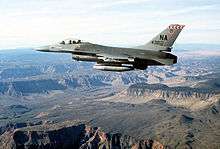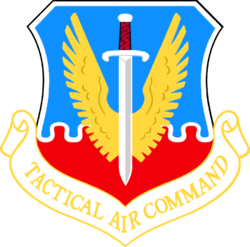430th Expeditionary Electronic Combat Squadron
430th Expeditionary Electronic Combat Squadron
 | |
|---|---|
_67-037_with_Cannon-based_F-16_524th_TFS.jpg) | |
| Active | 1943–1945; 1952–1966; 1968–1989; 1992–1993; 2013–present |
| Country |
|
| Branch |
|
| Role | Electronic Warfare |
| Size | Squadron |
| Garrison/HQ | Kandahar Airfield |
| Engagements |
European Theater of Operations Korean War Vietnam War[1] Afghanistan War |
| Decorations |
Distinguished Unit Citation Air Force Outstanding Unit Award Belgian Fourragère Republic of Korea Presidential Unit Citation Republic of Vietnam Gallantry Cross with Palm[1] |
| Insignia | |
| 430th Expeditionary Electronic Combat Squadron emblem (approved 15 July 1954)[1] |
|
| 430th Fighter Squadron emblem (World War II)[2] |
 |

The 430th Expeditionary Electronic Combat Squadron is an active United States Air Force unit. It is assigned to the 451st Expeditionary Operations Group and stationed at Kandahar Air Base, Afghanistan.
The squadron was first activated during World War II and served in the European Theater of Operations, where it earned a Distinguished Unit Citation and the Belgian Fourragère for its actions in combat. It remained in Europe after V-E Day, returning to the United States, where it was inactivated at the Port of Embarkation in December 1945.
The squadron was reactivated as the 430th Fighter-Bomber Squadron in 1952, when it replaced an Air National Guard squadron in Japan. It again saw combat in the Korean War, earning another Distinguished Unit Citation and a Republic of Korea Presidential Unit Citation. The squadron returned to the United States in 1954, but made frequent overseas deployments, including combat in the Vietnam War. It remained a fighter unit until inactivating in 1989.
In 1992, the unit became the 430th Electronic Combat Squadron, but was only active for one year. It was converted to provisional status and received its current name in 2013.
History
World War II
Activated in August 1943 as a Lockheed P-38 Lightning fighter squadron under IV Fighter Command in Southern California. Trained with the fighter over the Mojave Desert, moving to the European Theater of Operations, being assigned to Ninth Air Force in England during March 1944.
Engaged in combat operations beginning in April, making low level sweeps over Occupied France, attacking enemy transportation targets and military convoys, bridges, armor formations and airfields. During D-Day, the squadron flew patrols over the invasion fleet. Remained in England after D-Day until August, moving to France and primarily provided ground-air support to the United States First Army in Northern France. Moved to Occupied Germany at the end of the war, becoming part of the United States Air Forces in Europe army of occupation during the summer of 1945.
Personnel demobilized in Europe during 1945, returned to the United States in November as an administrative unit and was inactivated without personnel or equipment.
Cold War
Reactivated in Japan under Far East Air Forces, July 1952 as a result of the Korean War. Replaced Federalized Georgia Air National Guard personnel, receiving their Republic F-84G Thunderjets. Moved to South Korea in August, engaging in combat operations from Kunsan Air Base (K-8). From Kunsan the squadron bombed and strafed bridges, bunkers, troop concentrations, artillery positions, and a host of other enemy targets
Moved to Taegu Air Base (K-2) in April 1953 being attached to the 58th Fighter-Bomber Wing. Flew interdiction and close air support missions in as well as attacking special strategic targets such as military schools, dams, and port facilities in North Korea until the June 1953 Armistice, Remained in South Korea for over a year afterward to insure Communist compliance with the cease-fire.
Returned to Clovis Air Force Base, New Mexico in November 1954. Squadron was re-equipped with Nort American F-86H Sabre fighter-bomber aircraft, being assigned to Twelfth Air Force, Tactical Air Command. Maintained proficiency in tactical fighter operations, deploying components, aircraft, and crews on a global basis in support of NATO, PACAF, AAC, and other organizations. Deployed to southeastern United States during the Cuban Missile Crisis of 1962.
Moved to Nellis Air Force Base, Nevada in 1966, becoming one of the first General Dynamics F-111A squadrons. Deployed aircraft to South Vietnam in early 1968, while still in training status at Nellis. Aircraft returned and development of the F-111 continued, finally reaching operational status in 1971.
Returned to Takhli Royal Thai Air Force Base, Thailand in early 1972 as a result of the North Vietnamese Easter Offensive. Fully engaged in combat over North and South Vietnam for the balance of 1972, flying operations in good and bad weather when other squadrons were grounded. Flew approximately 4000 combat missions with excellent success rates in hitting targets even when visibility was near zero. Returned to the United States in March 1973.
Engaged in training new pilots with the F-111 during the mid-1970s, changing equipment to the McDonnell F-4D Phantom II in 1975 during "Operation Ready Switch", sending F-111s to the 366th Tactical Fighter Wing at Mountain Home Air Force Base, Idaho. Received new Block 1/5 General Dynamics F-16A Fighting Falcon aircraft in November 1980 after protractive development period in the 1970s. Conducted routine Tactical Air Command training and deployments from Nellis with the F-16s, upgrading to Block 10/15 models in the early 1980s. Inactivated September 1989 when aircraft were considered no longer front-line combat capable.
Electronic combat
Reactivated at Cannon Air Force Base, New Mexico as the 430th Electronic Combat Squadron in August 1992 in conjunction with the realignment of all General Dynamics EF-111A Raven Electronic Warfare aircraft from Mountain Home to Cannon. Relieved aircraft and trained 27th Operations Group personnel in operational use. Once the move was completed the 430th was inactivated and squadron personnel and aircraft were transferred to the 429th Electronic Combat Squadron.
The squadron was reactivated as the 430th Expeditionary Electronic Combat Squadron, Kandahar Airfield, Afghanistan on 13 March 2013, when it replaced the 451st Air Expeditionary Wing's tactical airborne gateway, which had been operating since 2006. The unit flies the Northrop Grumman E-11 aircraft. The mission of the E-11A is to serve as a Battlefield Airborne Communications Node, a communications system that provides voice and data connectivity across the battlespace for air and surface operators.[3]
Lineage
- Constituted as the 430th Fighter Squadron on 26 May 1943
- Activated on 1 August 1943
- Inactivated on 7 December 1945
- Redesignated 430th Fighter-Bomber Squadron on 25 June 1952
- Activated on 10 July 1952
- Redesignated 430th Tactical Fighter Squadron on 1 July 1958
- Inactivated on 15 November 1966
- Activated on 15 September 1968
- Inactivated on 30 September 1989
- Redesignated 430th Electronic Combat Squadron and activated 1 August 1992
- Inactivated 29 June 1993
- Redesignated 430th Expeditionary Electronic Combat Squadron and converted to provisional status on 13 March 2013[1]
- Activated c. 13 March 2013[4]
Assignments
- 474th Fighter Group, 1 August 1943 – 7 December 1945
- 474th Fighter-Bomber Group, 10 July 1952 (attached to 58th Fighter-Bomber Wing 1 April 1953 – 22 November 1954)
- 474th Fighter-Bomber Wing (later 474th Tactical Fighter Wing), 8 Oct 1957 – 15 November 1966
- 474th Tactical Fighter Wing, 15 September 1968 — 30 September 1989
- 27th Operations Group, 1 August 1992 – 29 June 1993[1]
- 451st Expeditionary Operations Group 13 Mar 2013 – present[4]
Stations
|
|
Aircraft
|
|
References
- Notes
- ↑ Aircraft is General Dynamics EF-111A Raven serial 67-37.
- Citations
- 1 2 3 4 5 Robertson, Patsy (7 May 2013). "Factsheet 430 Expeditionary Electronic Combat Squadron (ACC)". Air Force Historical Research Agency. Retrieved 2 July 2017.
- ↑ Watkins, pp. 54-55
- ↑ Welsh, Patty (2 February 2016). "Comms program hits 100,000 hours of warfighter connectivity". United States Air Public Affairs. Retrieved 3 July 2017.
- 1 2 3 4 Hinderliter, Capt Tristan (15 March 2013). "Same mission, new name for E-11A unit at Kandahar Airfield". 451st Air Expeditionary Wing Public Affairs. Retrieved 3 July 2017.
- ↑ Station number in Anderson.
- 1 2 3 4 5 6 7 8 Station number in Johnson.
Bibliography
![]()
- Anderson, Capt. Barry (1985). Army Air Forces Stations: A Guide to the Stations Where U.S. Army Air Forces Personnel Served in the United Kingdom During World War II (PDF). Maxwell AFB, AL yes: Research Division, USAF Historical Research Center. Archived from the original (PDF) on 23 January 2016. Retrieved 28 June 2017.
- Johnson, 1st Lt. David C. (1988). U.S. Army Air Forces Continental Airfields (ETO) D-Day to V-E Day (PDF). Maxwell AFB, AL: Research Division, USAF Historical Research Center. Archived from the original (PDF) on 29 September 2015. Retrieved 26 June 2017.
- Martin, Patrick (1994). Tail Code: The Complete History of USAF Tactical Aircraft Tail Code Markings. Atglen, PA: Schiffer Military Aviation History. ISBN 0-88740-513-4.
- Maurer, Maurer, ed. (1983) [1961]. Air Force Combat Units of World War II (PDF) (reprint ed.). Washington, DC: Office of Air Force History. ISBN 0-912799-02-1. LCCN 61060979. Retrieved 17 December 2016.
- Maurer, Maurer, ed. (1982) [1969]. Combat Squadrons of the Air Force, World War II (PDF) (reprint ed.). Washington, DC: Office of Air Force History. ISBN 0-405-12194-6. LCCN 70605402. OCLC 72556. Retrieved 17 December 2016.
- Ravenstein, Charles A. (1984). Air Force Combat Wings, Lineage & Honors Histories 1947-1977 (PDF). Washington, DC: Office of Air Force History. ISBN 0-912799-12-9. Retrieved 17 December 2016.
- Rogers, Brian. (2005). United States Air Force Unit Designations Since 1978. Hinkley, UK: Midland Publications. ISBN 1-85780-197-0.
- Watkins, Robert (2008). Battle Colors. Vol III Insignia and Markings of the Ninth Air Force In World War II. Atglen, PA: Shiffer Publishing Ltd. ISBN 978-0-7643-2938-8.

